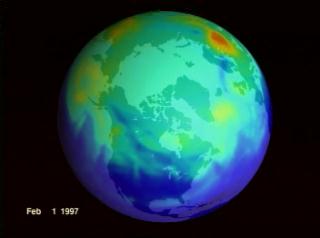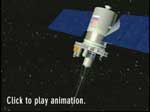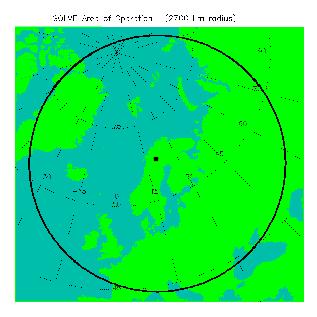October 30, 2002 - (date of web publication)
NASA JOINS INTERNATIONAL OZONE STUDY IN ARCTIC
|
Caption for Image/Animation 1:
Arctic Ozone Hole from Earth Probe TOMS: February 1, 1997 through May 31, 1997
|
NASA researchers will join more than 350 scientists from the United States, the European Union, Canada, Iceland, Japan, Norway, Poland, Russia and Switzerland this winter to measure ozone and other atmospheric gases using aircraft, large and small balloons, ground-based instruments and satellites.
This second SAGE III Ozone Loss and Validation Experiment (SOLVE II) campaign will be conducted in close collaboration with the European Commission, sponsored by the VINTERSOL (Validation of International Satellites and Study of Ozone Loss) campaign. (SAGE III stands for the third Stratospheric Aerosol and Gas Experiment.) SOLVE will take place in Kiruna, Sweden, the site of the first international effort during the winter of 1999-2000.
|
Caption for Image 2: SAGE III INSTRUMENT BEING USED FOR THE SOLVE MISSION The Stratospheric Aerosol and Gas Experiment (SAGE III) instrument aboard the Russian Meteor-3M spacecraft will be used during the SOLVE-2 campaign. SAGE III is the copper-colored box-like instrument on the lower right. The instrument is commanded and controlled by personnel at the SAGE III Mission Operations Center at NASA Langley Research Center. Data are down-linked twice daily to the NASA Wallops Flight Facility and to a Russian receiving station. It will be processed and will made available at the Langley Research Center's Atmospheric Sciences Data Center. The goal of SAGE III is to measure high resolution vertical profiles of key components of the upper atmosphere-the most important being ozone, aerosols (suspended particles) and water vapor. These measurements will enhance our understanding of climate and how human activities influence it. CREDIT: NASA Langley |
"The primary goals of the joint SOLVE II-VINTERSOL campaign are to further understanding of ozone loss processes in the Arctic, and verify that satellite observations of the ozone layer are accurate from space," said Michael Kurylo, SOLVE II co-Program Scientist at NASA Headquarters, Washington.
Ozone studies are important because the ozone layer prevents the sun's harmful ultraviolet radiation from reaching the Earth's surface. Ultraviolet radiation is a primary cause of skin cancer. Without protective upper-level ozone, there would be no life on Earth.
|
Caption for Image/Animation 3:
SAGE III IN ORBIT
|
The Arctic campaign will run from Jan. 8 through Feb. 6, 2003. Flights of large balloons will augment the aircraft campaign, extending the measurement period from late November 2002 to late March 2003.
During the campaign of 1999-2000, record ozone losses of 70 percent were observed at altitudes around 18 kilometers (11 miles) and a great deal was learned about the processes leading to the rapid ozone loss in the Arctic. The SOLVE II campaign will add to that body of knowledge.
|
Caption for Image 4: AREA OF MISSION OPERATION SOLVE-THESEO 2000 was a joint effort between scientists from the U.S., Europe, Russia and Japan and the largest field campaign to observe stratospheric ozone changes in the Arctic. The experiment occurred during the 1999-2000 winter in Kiruna, Sweden. CREDIT: Image courtesy of NASA Scientific Visualization Studio (SVS) |
During the coming winter, scientists in SOLVE II-VINTERSOL also will work toward ensuring the accuracy of measurements from current Earth observing satellites. Scientists will take measurements of the stratosphere using a large suite of instruments aboard NASA's DC-8 aircraft and the European high-flying aircraft M55 Geo-physica, the German DLR Falcon. An instrument from NASA's Jet Propulsion Laboratory in Pasadena, Calif., will also fly on the M55 Geophysica. These planes will be based in Kiruna.
|
Caption for Image 5: ARCTIC OZONE LOSS WINTER 1999-2000 On average scientists observed a 55 percent decrease of Arctic ozone in the stratosphere during the 1999-2000 winter. In this image using data from NASA's TOMS Earth Probe, blue regions represent the difference between ozone levels observed in the early 1980s and the 1999-2000 winter. CREDIT: Image courtesy of NASA SVS |
Research balloons, carrying payloads weighing up to several hundred pounds will be launched from Kiruna by teams from the Centre National d'Etudes Spatiales (France's National Center for Space Studies) and NASA. A network of over 30 stations of ground-based instruments will take atmospheric readings over a wide area, which will show how the chemical composition of Arctic stratosphere evolves through the whole winter.
|
Caption for Image 6: POLAR STRATOSPHERIC CLOUDS Extremely low Arctic temperatures enabled polar stratospheric clouds (PSCs) to last longer during the 1999-2000 winter, causing additional ozone loss. CREDIT: Image courtesy of the NASA SOLVE Mission. |
VINTERSOL is a pan-European campaign involving researchers supported by the European Commission and national research agencies. NASA's SAGE III satellite instrument is being used to quantitatively assess ozone loss in the higher latitudes. SAGE III was launched onboard a Russian Meteor-3M spacecraft on December 10, 2001. The validation of the SAGE III observations is a principal goal of SOLVE II.
SOLVE II is sponsored by NASA's Earth Science Enterprise, dedicated to better understanding and protecting our home planet.
|
Caption for Image 7:
SOLVE'S MISSION GOALS AND LOCATIONS
|
NOTE TO EDITORS:
The SOLVE campaign will hold a media week beginning Monday, Jan. 27, 2003. During that week, members of the media may schedule appointments for interviews with specific researchers. Also, a "Media Day" open house will be held at the Arena Arctica Hangar on Wednesday, Jan. 29, 2003. Researchers will be available throughout Media Day to answer questions and provide tours of the hangar and operations.
All media visiting Arena Arctica must coordinate their visit during media week or the open house with NASA Public Affairs and Kiruna Airport Security.
For more information contact:
Elvia Thompson
Headquarters, Washington
(Phone: 202/358-1696)
Rob Gutro/Cynthia O'Carroll
Goddard Space Flight Center, Greenbelt, Md.
(Phone: 301/286-4044 or 301/614-5563)
Information for SOLVE Media Week






